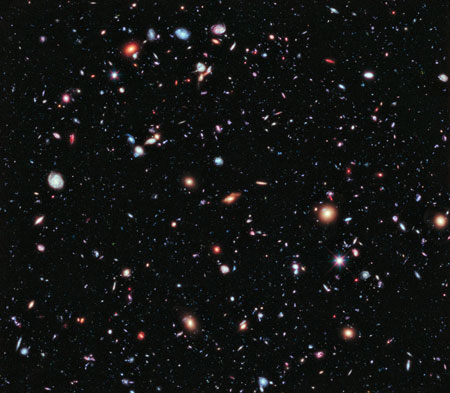The Hubble Space Telescope has been busy for the past decade. After looking at the same spot in the sky for a total of 2 million seconds it has produced what NASA calls the "farthest-ever" portrait of the universe, reports Rebecca J. Rosen.
The resulting image, or compilation of images, is called eXtreme Deep Field, or XDF. The photo below "contains around 5,500 galaxies, some of which are one ten-billionth the brightness visible to the human eye...For the oldest galaxies in the image, the light now reaching us first shone some 13.2 billion years ago, more than 8.6 billion years before Earth even existed," says Rosen.
"Perhaps more mind-boggling than the number of objects in the image, or just how far away they are, is what a tiny speck of the night sky they all sit in." See the article for an illustratation and video depicting the teensy part of the sky shown in the image.

FULL STORY: The Deepest Portrait of Our Universe Yet

Maui's Vacation Rental Debate Turns Ugly
Verbal attacks, misinformation campaigns and fistfights plague a high-stakes debate to convert thousands of vacation rentals into long-term housing.

Planetizen Federal Action Tracker
A weekly monitor of how Trump’s orders and actions are impacting planners and planning in America.

In Urban Planning, AI Prompting Could be the New Design Thinking
Creativity has long been key to great urban design. What if we see AI as our new creative partner?

King County Supportive Housing Program Offers Hope for Unhoused Residents
The county is taking a ‘Housing First’ approach that prioritizes getting people into housing, then offering wraparound supportive services.

Researchers Use AI to Get Clearer Picture of US Housing
Analysts are using artificial intelligence to supercharge their research by allowing them to comb through data faster. Though these AI tools can be error prone, they save time and housing researchers are optimistic about the future.

Making Shared Micromobility More Inclusive
Cities and shared mobility system operators can do more to include people with disabilities in planning and operations, per a new report.
Urban Design for Planners 1: Software Tools
This six-course series explores essential urban design concepts using open source software and equips planners with the tools they need to participate fully in the urban design process.
Planning for Universal Design
Learn the tools for implementing Universal Design in planning regulations.
planning NEXT
Appalachian Highlands Housing Partners
Mpact (founded as Rail~Volution)
City of Camden Redevelopment Agency
City of Astoria
City of Portland
City of Laramie





























